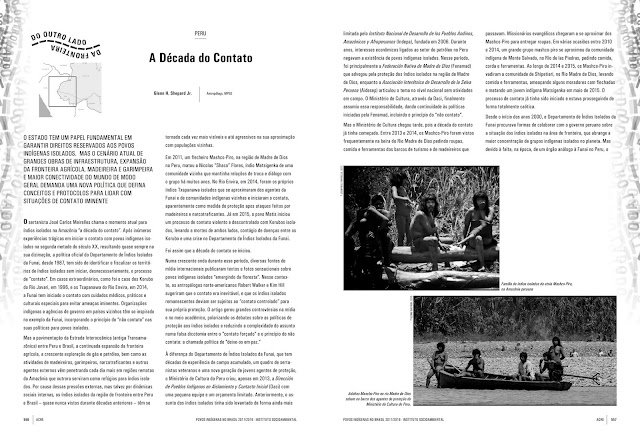But the paving of the Inter-Oceanic Highway (formerly known as the ”Trans-Amazon Highway”) between Peru and Brazil, the continued expansion of the agricultural frontier, the growing demand for oil and gas exploration, and the activities of loggers, gold miners, drug traffickers and other outside agents are increasingly penetrating remote regions of the Amazon that once served as refuges for isolated peoples. Because of these external pressures, but perhaps also owing to their own internal dynamics, isolated indigenous peoples from the border region between Peru and Brazil — almost never seen in previous decades — have become increasingly visible and even aggressive in their interactions with neighboring populations.
And so began the Decade of Contact…
 |
| Roads, oil and gas concessions, logging and mining interests are edging in on the territory of isolated indigenous peoples (Image: Science Magazine). |
… A growing wave of international media outlets have published sensational texts and photos about isolated indigenous peoples "emerging from the forest." In this context American anthropologists Robert Walker and Kim Hill suggested that contact was inevitable, and that the remaining isolated peoples should be subject to "controlled contact" for their own protection. The article generated tremendous controversy in the media and in academic circles, polarizing debates around policies for protecting isolated indigenous peoples and reducing the complexity of the subject to a false dichotomy between "forced contact" and the principle of no-contact: the so-called “Leave them alone" policy…
… National governments play a key role in guaranteeing the territories, rights, health and cultural integrity of isolated indigenous peoples. But the current scenario of road-building, major infrastructure projects and expansion of the agricultural, logging and mining frontier takes outside agents ever closer to isolated peoples while contributing to an increased curiosity among isolated peoples themselves. This situation demands new policies, concepts and protocols to deal with situations of imminent contact. The Decade of Contact has arrived. A naive "no contact" policy — "Leave them alone!" — has become not only a contradiction, but an act of neglect.
---
Excerpted and translated from “A década do contato," in: B. Ricardo & F. Ricardo (Eds.) Povos Indígenas no Brasil 2011/2016. São Paulo: Instituto Socioambiental, 556-559 (2017).
Read the full article (in Portuguese) at Academia.edu
A revised version of this work was presented at the seminar on "Indigenous peoples in voluntary isolation: Anthropological perspectives" in Rio de Janeiro, Sept. 24-25, 2018
A revised version of this work was presented at the seminar on "Indigenous peoples in voluntary isolation: Anthropological perspectives" in Rio de Janeiro, Sept. 24-25, 2018







